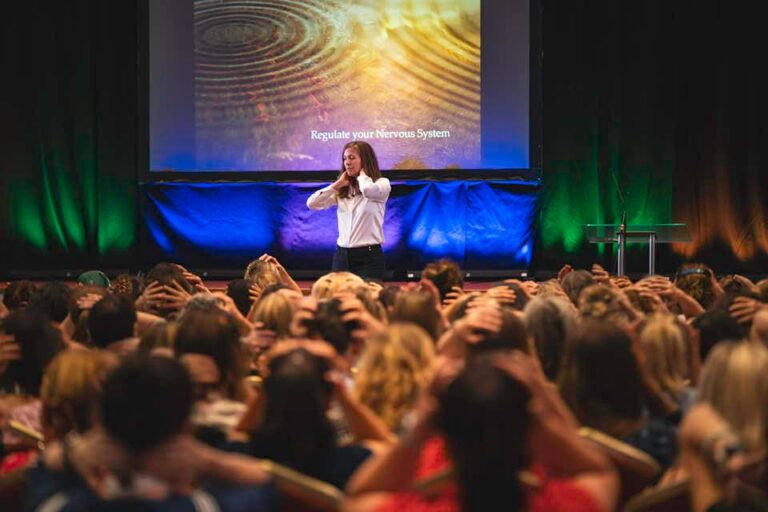This post is something I am very passionate about. I’ve noticed that both art and play therapy leave people thinking what is that, how does that work? So, I thought I would share my story on how I discovered it, what it is, and how it works.
How I discovered Play Therapy
During my time working as a Counsellor Advocate at a Centre Against Sexual Assault I was lucky enough to attend a Synergetic Play Therapy (SPT) training event (Integrating Extremes: A Synergetic Approach for Integrating Aggression and Death in the Playroom). It was facilitated by Lisa Dion the founder of Synergetic Play Therapy, Lisa is such an authentic and informative speaker. This training changed my whole perspective on therapy and ultimately changed my career trajectory. I was trained in a psychodynamic art psychotherapy model and I found this SPT training helped me understand more of the how and why art therapy works.
I became so inspired and passionate about this, that I ended up doing a presentation about this at the ANZACATA conference in Melbourne ( “Integrating Trauma in the Art Psychotherapy Room ” It referenced SPT and the valuable theory and approach learnt from the training.) I have using this approach with art and play therapy in private practice and as a Senior Clinician at Play Therapy Melbourne for the last three years. It’s easy to say I love the work that is founded in this model. I have to preface that I’m not a registered play therapist but I utilise the training to enhance my art therapy practice. I also use the play skills learned during this training with young children if they want to play with toys.
What is Play and Art Therapy?
Synergetic Play Therapy and Art Psychotherapy are two therapeutic modalities that offer powerful approaches for healing and growth in individuals, particularly children. This blog post delves into the neurobiological and neuroscience aspects of these therapies, focusing on the concepts of attunement and co-regulation. By understanding these links, we can appreciate how these modalities support emotional regulation, brain development, and interpersonal connections.
What are these Neurobiological Foundations?
Attunement refers to the therapist’s ability to empathically connect with the client, creating a safe and supportive environment. Neurobiologically, attunement activates mirror neurons, which play a crucial role in understanding and sharing emotions. This process enhances emotional regulation and promotes a sense of safety and trust. Co-regulation involves the therapist and client engaging in a mutually responsive interaction, regulating each other’s emotions and nervous systems. This process activates the social engagement system, which includes the ventral vagal complex, promoting relaxation, connection, and emotional well-being.
Synergetic Play Therapy and Art Psychotherapy
Synergetic Play Therapy: This approach combines play therapy techniques with neuroscience principles. Through play, children can express and process their emotions, experiences, and traumas. The therapist attunes to the child’s play, providing a safe space for exploration and healing. The use of play materials and activities engages the child’s imagination and creativity, facilitating emotional regulation and brain integration.
Art Psychotherapy: Art psychotherapy utilizes various art forms, such as drawing, painting, and sculpting, to promote self-expression and emotional healing. The therapist attunes to the client’s artistic process, providing support and guidance. Art-making activates brain regions associated with emotional processing, memory, and self-reflection, facilitating emotional regulation and neural integration.
How are they linked?
It is important to note, this is how I approach the subject in my own practice and different Art Therapists will have different interventions in their ‘toolbox’. Everybody has different styles and it is important to find the ones that work for you.
Both Synergetic Play Therapy and Art Psychotherapy foster attunement between the therapist and client. The empathic connection and mirroring of emotions activate mirror neurons, promoting emotional regulation and interpersonal understanding. Art Therapy for me, mirrors the triangular relationship that Play Therapy has. As there is the:

1. Client
2. Therapist and
3. Toy or Art Material.
With both the toy or the art; there is a similar process to assess (movement, themes, developmental age of interaction and content). The interactive nature of play and art therapy also allows for co-regulation between the therapist and client. This co-regulation activates the social engagement system, promoting relaxation, connection, and emotional well-being. It can also become a strong container for big emotions, so the therapist can safely guide the client to explore, process and re-integrate the experience.
Benefits and Outcomes
Both modalities support emotional regulation by providing a safe and supportive environment for expression and exploration. Informed by neuroscience theory and an understanding of the neurobiology research that supports nervous system regulation. The neurobiological processes involved in attunement and co-regulation during therapy contribute to healthy brain development, particularly in areas related to emotional processing and interpersonal connections. Through attunement and co-regulation, clients develop improved interpersonal skills, such as empathy, emotional understanding, and effective communication. Client’s can also process and learn new coping mechanisms in the play or art making through authentic expression of emotions, safely being modelled regulation skills and build new neural pathways to increase their window of tolerance.
Synergetic Play Therapy and Art Psychotherapy offer valuable therapeutic approaches that integrate neuroscience principles. The concepts of attunement and co-regulation play a crucial role in these modalities, supporting emotional regulation, brain development, and interpersonal connections. By understanding the neurobiological links, we can appreciate the transformative power of these therapies in promoting healing, growth, and well-being – not just with children, but all ages.
(Image: Artist unknown)
By Vicki Soar
*Original blog post can be found here: https://www.soararttherapy.com/post/links-between-art-and-play-therapy
Would you like to learn Synergetic Play Therapy? Join us for one of our level 1 Introduction to Synergetic Play Therapy programs, online or in person. Discover more about this program here.
References:
1. Perry, B. D. (2009). Examining child maltreatment through a neurodevelopmental lens: Clinical applications of the neurosequential model of therapeutics. Journal of Loss and Trauma, 14(4), 240-255.
· This article discusses the neurobiological foundations of attunement and co-regulation in the context of child maltreatment and trauma.
2. Synergetic Play Therapy Institute. (n.d.). What is Synergetic Play Therapy? https://synergeticplaytherapy.com/what-is-synergetic-play-therapy/
· The Synergetic Play Therapy Institute provides an overview of Synergetic Play Therapy, explaining its principles and approach.
3. Malchiodi, C. A. (2019). Art therapy and somatic experiencing: A transdisciplinary approach to trauma treatment. The Arts in Psychotherapy, 63, 1-8.
· This study explores the integration of art therapy and somatic experiencing, highlighting the effectiveness of this transdisciplinary approach in reducing trauma symptoms and enhancing emotional regulation.
4. American Art Therapy Association. (n.d.). What is Art Therapy? www.arttherapy.org/what-is-art-therapy/
· The American Art Therapy Association provides an overview of art therapy, explaining its principles and benefits.
5. Vaisvaser S. (2021) The Embodied-Enactive-Interactive Brain: Bridging Neuroscience and Creative Arts Therapies. Front Psychol.
This is an amazing article which explains the brains activity during creative arts therapies. This discusses the brains activity in many stages but also explores the “predictive processing” role in Creative Arts Therapies.
6. Mastandrea S, Fagioli S, Biasi V. (2019) Art and Psychological Well-Being: Linking the Brain to the Aesthetic Emotion.
This article discusses the relationship between art and the brain, in relation to the aesthetic experience.




